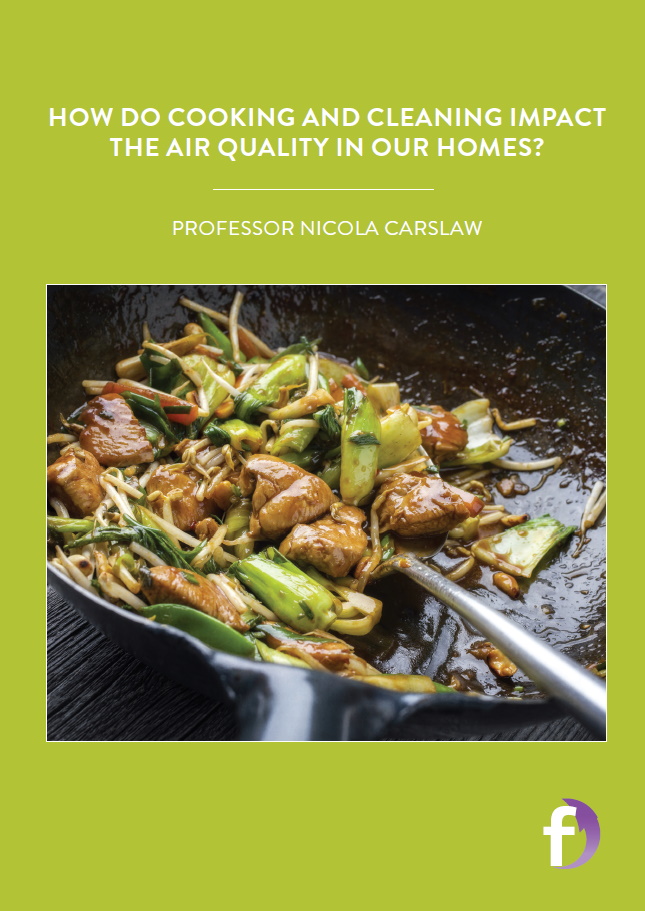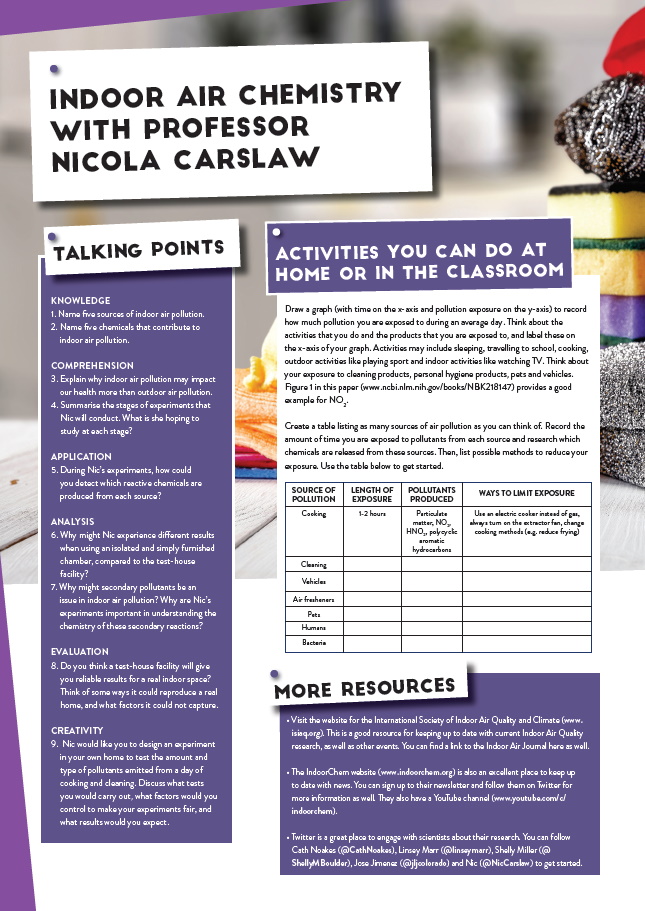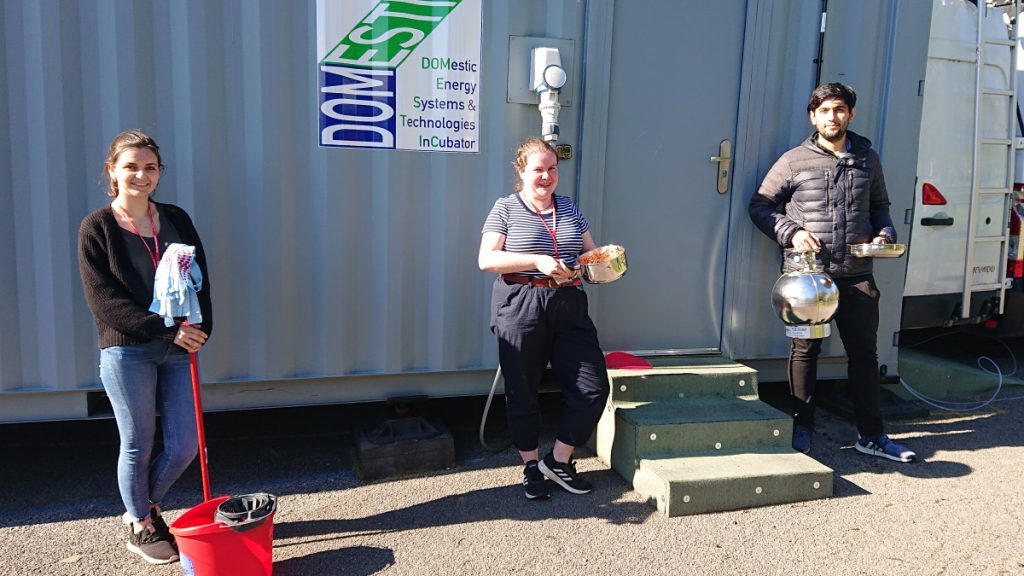How do cooking and cleaning impact the air quality in our homes?
When we consider our exposure to pollution, we usually think about vehicle exhaust fumes or industrial emissions. Indoor air pollution is rarely discussed. Yet we spend most of our lives indoors, where chemicals produced by everyday tasks such as cooking and cleaning can have harmful effects on our health. At the University of York, in the UK, Professor Nicola Carslaw is studying the complex chemistry of indoor air pollution in the hope of limiting our exposure to pollution inside our homes, schools and workspaces
TALK LIKE AN AIR CHEMIST
AIR POLLUTANT – a substance in the atmosphere that is harmful to the health of humans, other animals, plants, materials or the climate
CARCINOGENIC – a substance that has the ability to cause cancer
COMBUSTION REACTION – a chemical reaction caused by burning
INDOOR AIR CHEMISTRY – the study of chemical reactions that occur indoors
PHOTOLYSIS REACTION – a reaction in which chemical bonds are broken down by exposure to sunlight
SECONDARY POLLUTANT – a new pollutant produced by the chemical reaction of other pollutants
SICK BUILDING SYNDROME – a recurring illness with symptoms including a sore throat, wheezing and coughing while indoors. Symptoms are alleviated when the occupant leaves the building
We all understand that we are exposed to air pollution if we walk next to a busy road full of vehicles pumping out exhaust fumes, but we rarely think that pollution is an issue when we are inside. However, indoor air pollution can be a significant problem. And as we spend around 90% of our lives indoors, most of our exposure to air pollutants will occur when we are inside. So, it is important to understand what these are and how they act.
Professor Nicola Carslaw is an indoor air chemist at the University of York. She leads the IMPeCCABLE project (IMPacts of Cooking and Cleaning on indoor Air quality: towards healthy BuiLdings for the futurE), designed to investigate the sources of pollution emissions and the chemical reactions that occur following their release, with the aim of improving building design to reduce our exposure to indoor air pollution.
WHAT ARE THE SOURCES OF INDOOR AIR POLLUTION?
Pollutants are released from items or during tasks that we encounter daily. Cleaning products, air fresheners, paints and building materials, smoking and even pets all release chemicals and particles into the air of our homes, schools and workplaces. Many harmful pollutants are also created during combustion reactions. These include outdoor sources of pollution produced by vehicle emissions and industrial processes that enter buildings through windows or ventilation pipes. And indoors, combustion reactions occur when gas cookers, candles or wood stoves are used.
Not only are some of these pollutants directly harmful to our health, but even the nontoxic ones may undergo chemical reactions to produce harmful secondary pollutants. As Nic explains, “Many cleaning products contain limonene, a harmless chemical at typical indoor concentrations that creates a citrus scent. But when limonene is released indoors, the molecules go through a series of complex chemical reactions and eventually form formaldehyde, a toxic and carcinogenic secondary pollutant.”
HOW DO POLLUTANTS REACT DIFFERENTLY INDOORS?
Pollutants produced outdoors do not stay in the air in the air forever. Reactive chemicals can be removed by wind, rain or sunlight, but this is not the case indoors. Inside, there is less ventilation and no rainfall, and photolysis reactions occur much more slowly. This means that pollutants indoors have much less chance of dispersing than they do outdoors.
Indoors, there are also different types of surfaces that pollutants may react with. “Surface interactions are more important indoors and they have a large impact on the resultant chemistry,” says Nic. “This even includes the surfaces of people, as ozone can react with components of skin oil to produce secondary pollutants.”
WHAT IS OUR EXPOSURE TO AIR POLLUTION?
Our exposure to pollution will vary throughout the day. It is lowest when we are asleep, while travelling to and from school along busy roads will see a spike in exposure. Burning a scented candle for an hour can increase the concentration of nitrogen dioxide (NO2) to the World Health Organisation’s recommended limit. But your greatest exposure to pollutants will occur during cooking. Preparing an evening meal could increase the NO2 concentration to seven times the level of when you are asleep. This will depend on your cooking appliance (gas cookers release pollutants from combustion, electric cookers do not), your method of cooking (frying food releases far more particles than steaming) and the food itself (frying bacon is worse than frying vegetables!).
DOES INDOOR AIR POLLUTION IMPACT OUR HEALTH?
“There is evidence that occupational cleaners are more likely to develop asthma than workers with other occupations,” says Nic. “Research has also been conducted into ‘sick building syndrome’, an illness that causes itchy eyes, wheezing and sore throats as a result of exposure to indoor pollutants, but it is not known which of the many chemicals indoors cause this. Studies have also shown that lower ventilation rates in buildings are associated with inflammation, respiratory infections, asthma symptoms and short-term sick leave increases.”
THE IMPECCABLE PROJECT
To investigate indoor pollution emissions and their chemical reactions, Nic and her collaborators have set up a series of cooking and cleaning experiments. “Experiments will be carried out on increasing spatial scales, with each set informing the design and interpretation of the next,” explains Nic. Each test will involve using kitchen cleaning products and cooking meals such as chicken stir-fry, with each series of experiments increasing in complexity.
“We will start by studying cooking and cleaning in a controlled environment,” explains Nic. “We will cook and clean within a small chamber at the University of Chester and follow the evolution of the chemistry.” The team will then scale up their experiments in a larger chamber at the University of Nottingham, modelled to contain a kitchen. “This adds another layer of complexity,” says Nic, “such as through surface interactions (e.g. kitchen countertops and a lino floor) that were absent in the initial chamber.” The final stage will scale the experiments up to building-scale, using a test-house facility at the University of Chester. The cooking and cleaning activities will be repeated at house-scale, providing a complex, realistic environment where chemicals and processes can interact with each other.
FROM RESULTS TO APPLICATION
Nic will model the chemistry at each stage, introducing more surface interactions to make results more realistic. “We are aware that we need to make our conditions as relevant as possible, which is why we are moving from simple chambers through to more realistic environments like the test-house,” she says.
The results from these studies will be scaled up even further to inform best practices for building design and product manufacture. To ensure her results are relevant to the real world, Nic is working with a number of stakeholders including architects, catering managers, cleaning manufacturers and local government. Hopefully results from the IMPeCCABLE project will produce future policies that reduce our exposure to indoor air pollution in our homes and other buildings.
HOW CAN YOU REDUCE YOUR EXPOSURE TO INDOOR AIR POLLUTION?
“The best thing to do is avoid sources of air pollution in the first place,” says Nic. Cut down on the use of fragrances and cleaning products or replace sprays with roll-on deodorant and cream cleaners. Increase ventilation by opening windows and always use extractor fans when cooking and showering. Ultimately, you can change the air quality in your home or school by the actions you choose to take.
Reference
https://doi.org/10.33424/FUTURUM165
IMPeCCABLE team members Ellen, Catherine and Archit, ready to cook and clean in the test facility at the University of Chester.
Photo credit: Terry Dillon.
Heating oil and spices in a frying pan to understand the emissions released.
Photo credit: Terry Dillon.
Cooking chilli con carne to understand what happens when meat is fried and then heated in a tomato sauce. The first part of this process produces higher particulate matter emissions than the second.
Photo credit: Terry Dillon.
A test kitchen at the University of York, with some of the test equipment monitoring air pollutant concentrations following cleaning.
Photo credit: Terry Dillon.
Nic enjoying a cycle ride.
Photo credit: David Carslaw.
AIR POLLUTANT – a substance in the atmosphere that is harmful to the health of humans, other animals, plants, materials or the climate
CARCINOGENIC – a substance that has the ability to cause cancer
COMBUSTION REACTION – a chemical reaction caused by burning
INDOOR AIR CHEMISTRY – the study of chemical reactions that occur indoors
PHOTOLYSIS REACTION – a reaction in which chemical bonds are broken down by exposure to sunlight
SECONDARY POLLUTANT – a new pollutant produced by the chemical reaction of other pollutants
SICK BUILDING SYNDROME – a recurring illness with symptoms including a sore throat, wheezing and coughing while indoors. Symptoms are alleviated when the occupant leaves the building
We all understand that we are exposed to air pollution if we walk next to a busy road full of vehicles pumping out exhaust fumes, but we rarely think that pollution is an issue when we are inside. However, indoor air pollution can be a significant problem. And as we spend around 90% of our lives indoors, most of our exposure to air pollutants will occur when we are inside. So, it is important to understand what these are and how they act.
Professor Nicola Carslaw is an indoor air chemist at the University of York. She leads the IMPeCCABLE project (IMPacts of Cooking and Cleaning on indoor Air quality: towards healthy BuiLdings for the futurE), designed to investigate the sources of pollution emissions and the chemical reactions that occur following their release, with the aim of improving building design to reduce our exposure to indoor air pollution.
WHAT ARE THE SOURCES OF INDOOR AIR POLLUTION?
Pollutants are released from items or during tasks that we encounter daily. Cleaning products, air fresheners, paints and building materials, smoking and even pets all release chemicals and particles into the air of our homes, schools and workplaces. Many harmful pollutants are also created during combustion reactions. These include outdoor sources of pollution produced by vehicle emissions and industrial processes that enter buildings through windows or ventilation pipes. And indoors, combustion reactions occur when gas cookers, candles or wood stoves are used.
Not only are some of these pollutants directly harmful to our health, but even the nontoxic ones may undergo chemical reactions to produce harmful secondary pollutants. As Nic explains, “Many cleaning products contain limonene, a harmless chemical at typical indoor concentrations that creates a citrus scent. But when limonene is released indoors, the molecules go through a series of complex chemical reactions and eventually form formaldehyde, a toxic and carcinogenic secondary pollutant.”
HOW DO POLLUTANTS REACT DIFFERENTLY INDOORS?
Pollutants produced outdoors do not stay in the air in the air forever. Reactive chemicals can be removed by wind, rain or sunlight, but this is not the case indoors. Inside, there is less ventilation and no rainfall, and photolysis reactions occur much more slowly. This means that pollutants indoors have much less chance of dispersing than they do outdoors.
Indoors, there are also different types of surfaces that pollutants may react with. “Surface interactions are more important indoors and they have a large impact on the resultant chemistry,” says Nic. “This even includes the surfaces of people, as ozone can react with components of skin oil to produce secondary pollutants.”
WHAT IS OUR EXPOSURE TO AIR POLLUTION?
Our exposure to pollution will vary throughout the day. It is lowest when we are asleep, while travelling to and from school along busy roads will see a spike in exposure. Burning a scented candle for an hour can increase the concentration of nitrogen dioxide (NO2) to the World Health Organisation’s recommended limit. But your greatest exposure to pollutants will occur during cooking. Preparing an evening meal could increase the NO2 concentration to seven times the level of when you are asleep. This will depend on your cooking appliance (gas cookers release pollutants from combustion, electric cookers do not), your method of cooking (frying food releases far more particles than steaming) and the food itself (frying bacon is worse than frying vegetables!).
DOES INDOOR AIR POLLUTION IMPACT OUR HEALTH?
“There is evidence that occupational cleaners are more likely to develop asthma than workers with other occupations,” says Nic. “Research has also been conducted into ‘sick building syndrome’, an illness that causes itchy eyes, wheezing and sore throats as a result of exposure to indoor pollutants, but it is not known which of the many chemicals indoors cause this. Studies have also shown that lower ventilation rates in buildings are associated with inflammation, respiratory infections, asthma symptoms and short-term sick leave increases.”
THE IMPECCABLE PROJECT
To investigate indoor pollution emissions and their chemical reactions, Nic and her collaborators have set up a series of cooking and cleaning experiments. “Experiments will be carried out on increasing spatial scales, with each set informing the design and interpretation of the next,” explains Nic. Each test will involve using kitchen cleaning products and cooking meals such as chicken stir-fry, with each series of experiments increasing in complexity.
“We will start by studying cooking and cleaning in a controlled environment,” explains Nic. “We will cook and clean within a small chamber at the University of Chester and follow the evolution of the chemistry.” The team will then scale up their experiments in a larger chamber at the University of Nottingham, modelled to contain a kitchen. “This adds another layer of complexity,” says Nic, “such as through surface interactions (e.g. kitchen countertops and a lino floor) that were absent in the initial chamber.” The final stage will scale the experiments up to building-scale, using a test-house facility at the University of Chester. The cooking and cleaning activities will be repeated at house-scale, providing a complex, realistic environment where chemicals and processes can interact with each other.
FROM RESULTS TO APPLICATION
Nic will model the chemistry at each stage, introducing more surface interactions to make results more realistic. “We are aware that we need to make our conditions as relevant as possible, which is why we are moving from simple chambers through to more realistic environments like the test-house,” she says.
The results from these studies will be scaled up even further to inform best practices for building design and product manufacture. To ensure her results are relevant to the real world, Nic is working with a number of stakeholders including architects, catering managers, cleaning manufacturers and local government. Hopefully results from the IMPeCCABLE project will produce future policies that reduce our exposure to indoor air pollution in our homes and other buildings.
HOW CAN YOU REDUCE YOUR EXPOSURE TO INDOOR AIR POLLUTION?
“The best thing to do is avoid sources of air pollution in the first place,” says Nic. Cut down on the use of fragrances and cleaning products or replace sprays with roll-on deodorant and cream cleaners. Increase ventilation by opening windows and always use extractor fans when cooking and showering. Ultimately, you can change the air quality in your home or school by the actions you choose to take.
 PROFESSOR NICOLA CARSLAW
PROFESSOR NICOLA CARSLAW
University of York, UK
FIELD OF RESEARCH: Indoor Air Chemistry
RESEARCH PROJECT: Studying the pollutants and reactive chemicals released indoors by everyday cooking and cleaning tasks
FUNDER: EPSRC
ABOUT INDOOR AIR CHEMISTRY
Many everyday tasks release chemicals into the air in our homes. Nitrogen dioxide (NO2), nitrous acid (HNO2) and polycyclic aromatic hydrocarbons are released from combustion appliances when cooking or heating your home. Nitrogen oxides (NOX) and particulate matter are produced by vehicles and then enter buildings through windows and doors. Ozone (O3) is produced by chemical reactions outdoors and can also enter buildings through windows and doors. Cleaning products release ammonia, chlorinated volatile organic compounds (VOCs), acetic acid and limonene. Printers and photocopiers produce ozone. Mould and bacteria create microbial particles. And even humans emit chemicals through our skin and breath, such as unsaturated fatty acids, isoprene and squalene, not including those that we spray on ourselves in the form of deodorants, perfumes or hairsprays.
We do not think about these chemicals as we lead our daily lives, so Nic’s research is important to highlight the emissions and chemicals that we are exposed to indoors. Her experiments will help scientists understand what chemicals are released when we undertake everyday tasks such as cooking and cleaning. This will hopefully lead to changes in product manufacture, to reduce the pollutants emitted by cooking appliances and cleaning products, and also to changes in building design, to limit our exposure to any harmful chemicals.
WHAT DOES NIC FIND MOST REWARDING ABOUT RESEARCH IN HER FIELD?
“Studying indoor air pollution gives me a chance to apply my knowledge of chemistry to a real-world problem,” she explains. At university, Nic studied for a joint honours degree in chemistry with environmental science. She knew she did not want to do a pure chemistry degree as she was, “never interested in spending days in the lab synthesising minute quantities of chemicals.” Instead, she wanted her studies to be relevant to the environment or human health. Now a professor, Nic gets immense satisfaction from her job, not just from her research, but also from teaching her students. She hopes she can inspire some of them to take up jobs in air quality in the future.
WHAT ISSUES ARE FACING THE NEXT GENERATION OF INDOOR AIR CHEMISTS?
A key issue facing scientists in all fields is the need to generate, analyse and curate large quantities of data. Nic thinks we need more data management skills taught at schools and universities. “I am glad to see that coding is now making its way onto school curricula as this is another important skill that chemists need,” she says. Nic also highlights that future chemists need curiosity and the ability to work with people from other disciplines. “We need the next generation to come along and question things and to be willing to work at and across the boundaries of disciplines.”
EXPLORE A CAREER IN INDOOR AIR CHEMISTRY
• Keep abreast of the latest work in the field. The Indoor Air journal is the best place to read about the most recent research: www.onlinelibrary.wiley.com/journal/16000668
• Follow the leading scientists on Twitter – Cath Noakes (@CathNoakes), Linsey Marr (@linseymarr), Shelly Miller (@ShellyMBoulder) and Jose Jimenez (@jljcolorado) have provided valuable information during the pandemic on COVID transmission indoors.
• The IndoorChem website is a valuable community tool (www.indoorchem.org). Check out their YouTube channel: www.youtube.com/c/indoorchem
• Nic regularly delivers public lectures and is always happy to hear from people who want to learn more about the work she and her team conducts. Find her contact details and more about her work at: www.york.ac.uk/environment/ourstaff/nicola-carslaw
Nic recommends taking science subjects at school. “Maths, chemistry and physics is a good combination that keeps options open for many careers,” she says. “Then a science degree is always worthwhile.” You could follow this with a master’s degree in air quality or atmospheric science if you want to specialise in air pollution.
HOW DID NIC BECOME AN INDOOR AIR CHEMIST?
WHO OR WHAT INSPIRED YOU TO BECOME A SCIENTIST?
When I was young, I said that I wanted to be a scientist, without really understanding the implications of what that meant! My father was trained as a chemist and this probably influenced me more than I realised. I have been blessed with excellent supervisors during my studies and work, who have played a major role for me, and have been and still are an invaluable source of inspiration.
WHAT WERE YOUR INTERESTS AS A CHILD?
I was very passionate about sports. Soccer and basketball were two of my favourites. At school, I was always more interested in scientific topics.
WHAT ATTRIBUTES HAVE MADE YOU SUCCESSFUL AS A SCIENTIST?
Passion, curiosity and motivation.
HOW DO YOU OVERCOME OBSTACLES IN YOUR WORK?
I try to stay focused and think outside of the box. Interaction and discussion with my colleagues can be very helpful, as well.
WHAT ARE YOUR PROUDEST CAREER ACHIEVEMENTS?
My proudest career achievements are related to the impact I might have on my students. To see them grow and mature as scientists over the time they spend with us and help them shape their future careers is highly rewarding.
Work hard and follow your passions. If you end up working in an area you feel passionate about, it doesn’t feel like working.
Do you have a question for Nic?
Write it in the comments box below and Nic will get back to you. (Remember, researchers are very busy people, so you may have to wait a few days.)











